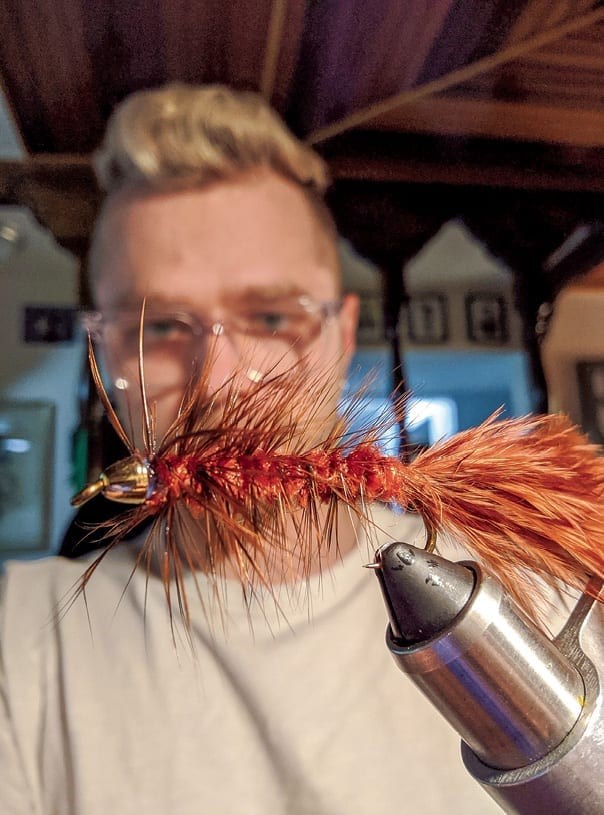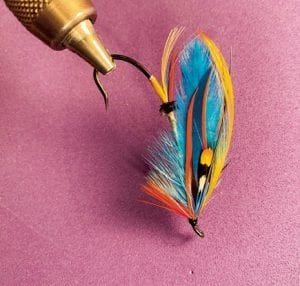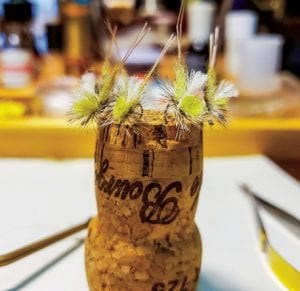Niagara Fly Tiers, denied their weekly meetings, get together online
Paul and the boys have been meeting every Tuesday evening during the fall and winter for more than 40 years to tie flies and tell fishing tales to while away the months when they can’t be on the water, fly rods in hand. They call their group of around 25 enthusiasts The Niagara Fly Tiers, and over the years the membership has changed but the enjoyment of crafting the delicate and beautiful lures from feathers and fur and bits of tinsel has not.
But now, unable to meet in the church basement where they have tying-benches and lighting, coffee machine and TV monitor for closeup views of the evening’s fly, they have been meeting remotely through a program called Cluster that allows each tier to post his latest creation and receive the comments and applause of the rest of the group. It lacks the social interaction that is such a valuable part of the weekly gatherings, but keeps the friends in contact and provides a forum for discussing materials and techniques and new discoveries.
Paul Furminger, Tom Meade, and Gary Kosinsky were among the originals who first began meeting to tie flies 40 years ago and are still active with the group today. Paul recalls doing a fly tying demonstration at the Queensway Hotel back in 1976, and among the fascinated observers was Dr. Earl Hunt, a well-known St. Catharines surgeon. Dr. Hunt was so taken with the art that he invited Paul and other interested anglers to his office on Yates St. in St. Catharines and cleared out a storage room for them to practice tying flies.
They continued to meet there every week for many years but when Dr. Hunt sold his building they were offered space in a long-closed fishing store in Port Dalhousie called Fishful Thinking. They met at different locations when the fishing store was sold, until finally landing in the basement of St. Andrew’s Church in St. Catharines where, between October and April, they have had (until March of this year) their weekly sessions for almost 20 years.
Every community in Niagara is represented among the Niagara Fly Tiers, from The Falls to Fort Erie, Welland, Pelham, St. Catharines, Vineland, Jordan, and points in between. Some, like Paul and Gary and Tom, have been tying for many years, while others are new to the craft and count themselves fortunate to be learning from the best. Some are avid, even fanatic fly fishers who produce flies that have the goal of tricking fish, while others never put their creations in the water. For them, tying flies is an end in itself. “Crafting for men,” it has been called.
Randy Greenall is a recent addition to the club, having joined three years ago at the invitation of his cousin, Morgan Stanford (who himself joined as a teenager and is now approaching retirement). Randy says it’s certainly easier and probably smarter to buy your fishing flies online, but tying your own flies has its rewards.
“The mechanics of tying fur and feather to a fishing hook can be done by most everyone with ten fingers, a few tools and a little patience,” says Greenall.
“You can make it as complex or as simple as suits you. Some get involved in fly tying initially due to a misguided attempt to save money. Others find a Zen-like peacefulness in the methodical complexities of the build. It’s what you make of it. In my case I’ve found a lot of joy in the camaraderie of like-minded fellas who have all fallen down the same rabbit hole as I have.”

With the online forum that has been forced on them to share their craft, the group has now expanded to include friends who live too far away to attend the Tuesday evening gatherings. David Breault chimes in from Prince George, B.C. and Brenda Clarke has joined from the other side of Hamilton. She posts the flies that she creates to donate to the Niagara Chapter of Trout Unlimited Canada for their Healing Waters Program to teach fishing and tying to injured Canadian soldiers. Brenda took up fly tying when she saw a demonstration at a store while on vacation Florida. Immediately intrigued she returned for more lessons, began tying as a hobby without any intention of fishing. But what to do with all the flies she was tying? The Healing Waters Program provided the answer and last year she joined the soldiers at the Legion in Fonthill to give each a box of her hand-crafted flies and help teach them the basics of tying. Several other members of the Niagara Fly Tiers are also part of the local TUC Chapter and participate in the conservation work it does along with the Healing Waters initiative.

Each week when they were able to meet, one of the group would lead the others in tying a fly of his choice. A GoPro camera recorded the process in closeup and sent the image to a large-screen TV so everyone could get a good view of the materials and the technique for assembling them on the barbless hooks they use to facilitate catch and release. Flies vary depending on the species of fish sought: tiny (5 mm) mayflies that float on the surface for trout, sinking shrimp imitations for saltwater bonefish, mouse imitations made of deer hair to attract bass, slinky 6-inch torpedoes that entice pike, and so on.
Every fly has a name, some clever, some fanciful, some evocative, catalogued in one of the thousands of books written on the subject of tying flies: Deceiver, Despair, Grey Ghost, Wooly Bugger, Muddler Minnow, Royal Coachman. The materials are as varied as those found in any sewing cabinet: thread in every colour and thickness imaginable; hair of deer, elk, badger, muskrat, squirrel; feathers from peacocks, ducks, partridge, grouse, pheasant, and many other more exotic birds; tinsel, wire, floss, and much, much more. Many of the materials are produced specifically for fly tying, but many more are found in craft stores, fabric shops, and novelty shops, while still others are provided by hunter friends.

Among the many flies that have been posted on the Cluster site over the past months, most members of the club agree that the prize for most intricate and skillfully tied fly goes to Gary Kosinsky, for his Lady Paul salmon fly, a creation he says took about five hours to tie. Would he fish with it?
“Not on your life!”
New tiers use the site to show attempts that aren’t quite right and seek advice, and some show flies they have had fishing success with, while others post pictures of flies that are enjoyable to tie or impressive to look at.
Sharing expertise is a hallmark of the club, as Randy Greenall asserts, “There’s so much knowledge and experience in the room. The club is lucky to have several members that are worthy of National Treasure status. It's a joy and somewhat mesmerizing to watch them build a fly.”
Fonthill resident Paul Verroche, a member for about 15 years, has provided much of the recent technical innovation to the club, including the use of the camera and TV monitor. He also produces an annual photo album of the year’s flies and tiers and events. He points out the varied skills of the group from wood carvers to painters, from musicians to bamboo rod builders. “Our Tuesday meetings offer way more than just a way to learn to tie a fly,” he says. “There is a wealth of skills across a broad base from many walks of life and age groups. We have much to learn from each other.”
The online site can’t reproduce the camaraderie of the weekly meetings, but gives the group a connection to their treasured Tuesday night sessions and provides a sense that come next October, they’ll be back in the church basement “tying flies and telling lies.”


